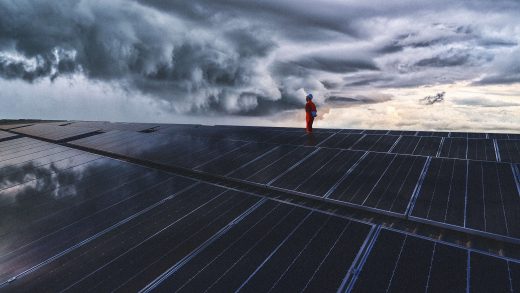How solar developers are making sure their panels aren’t ripped apart by hurricanes
How solar developers are making sure their panels aren’t ripped apart by hurricanes
Gale-force winds and dark skies during hurricanes pose major issues for solar power infrastructure.
During hurricanes, blackouts can be as life-threatening as the heavy rains and gale-force winds that cause them.
Perhaps the most clear evidence of this was during Hurricane Maria in 2017, which devastated Puerto Rico’s aging electrical grid and cut power to many homes, schools and hospitals for more than 100 days, depriving many of critical medical care. Since then, the U.S. territory—as well as other coastal regions and islands—have been beefing up their solar infrastructure to fortify grids and help keep the lights on during hurricanes, a strategy that proved effective for some Puerto Rican communities during Hurricane Fiona in 2022.
But climate change is fueling stronger and increasingly frequent storms, which have damaged solar panels on roofs and arrays alike. With an abnormally active Atlantic hurricane season on the horizon, solar infrastructure across coastal communities could be at risk this summer. I spoke with Luis Ceferino, a civil and environmental engineer at the University of California, Berkeley, to learn more about what types of hurricane conditions pose the biggest threats to solar panels.
“Hurricanes can bring strong winds and those winds can damage a lot of infrastructure,” Ceferino said. “We’re still understanding what impact these high winds bring on solar panels.”
Winds can reach more than 180 miles per hour during a Category 5 hurricane, which has the potential to rip a panel clean off its bracket. That’s what happened in 2017 when Hurricane Irma made landfall in the island of Barbuda, where officials from the Antigua Public Utilities Authority had been working on a 1-megawatt solar PV plant before the entire system was blown and washed away, reports Canary Media.
Solar panels in other nations in the Caribbean are similarly vulnerable during extreme storms—often due to the way they are built and installed, according to a 2023 study Ceferino led. The researchers analyzed wind fields and solar panel structural performance data in the Caribbean for Hurricanes Irma, Maria, and Dorian, and found that panels were failing at lower winds than they were supposed to and were performing below code requirements, particularly the ones installed on residential rooftops. The study’s authors found similar issues with panels in Florida.
Reported failures were often due to installation issues such as clamp failures, racking fractures, and buckling, bolt shear failure, and bolt loosening, according to the study.
“It seems like the problem is there but the scale of it, I don’t think we know yet,” Ceferino said. “People are working mostly on strengthening the panel itself so that it can sustain higher winds. I haven’t seen as many people working on new designs for the structure that supports the panel.”
Not all panels buckle under hurricane mayhem. For example, in a residential community in southwest Florida known as Babcock Ranch, developers designed their solar array (which includes nearly 700,000 panels) to withstand harsh conditions, a strategy that proved exceedingly successful during Hurricane Ian in 2022. Despite rolling blackouts in the surrounding areas, residents of Babcock Ranch enjoyed electricity—and even Wi-Fi—during the storm.
Other areas are testing out their own “hurricane-proof” solar infrastructure; nearly seven years after Irma, the UAE-Caribbean Renewable Energy Fund announced in March the completion of a solar project in Barbuda with panels designed to withstand around 165 mph (though this is still lower than peak winds during Irma). In the U.S., the utility company AES Corporation recently finalized a deal with the Australian company 5B to deploy nearly 1,400 of its modular solar arrays in Puerto Rico, which the company says were built to handle wind speeds of up to 166 mph, Eletrek reports.
However, hurricanes also pose a different issue to solar infrastructure that designers are going to be hard-pressed to solve: a lack of sun. At their peak, extreme storms can create clouds that are optically thick, blocking much of the sun’s rays—which means less power generation for panels, according to Ceferino.
“The clouds are transient. The problem is that they happen at the time of maximum crisis,” he said. “If you are a hospital that has solar panels and, on a normal day, is expected to produce a certain amount of energy, during a hurricane, you’re going to produce way less. And you have to take that into account.”
A group of researchers at Oak Ridge National Laboratory recently pitched creating a “super grid” that would connect the U.S. to the Caribbean islands using a network of undersea cables to help fill in solar energy gaps when the sky darkens. However, this concept is very much still in the simulation phase, and there are many unanswered questions surrounding its efficacy or potential environmental impacts.
In the meantime, wind-proofing solar arrays remains the focus for many developers—and this busy hurricane season will likely reveal how their approaches are faring.
—By Kiley Price, Inside Climate News
This article originally appeared on Inside Climate News. It is republished with permission.
ABOUT THE AUTHOR
(14)



